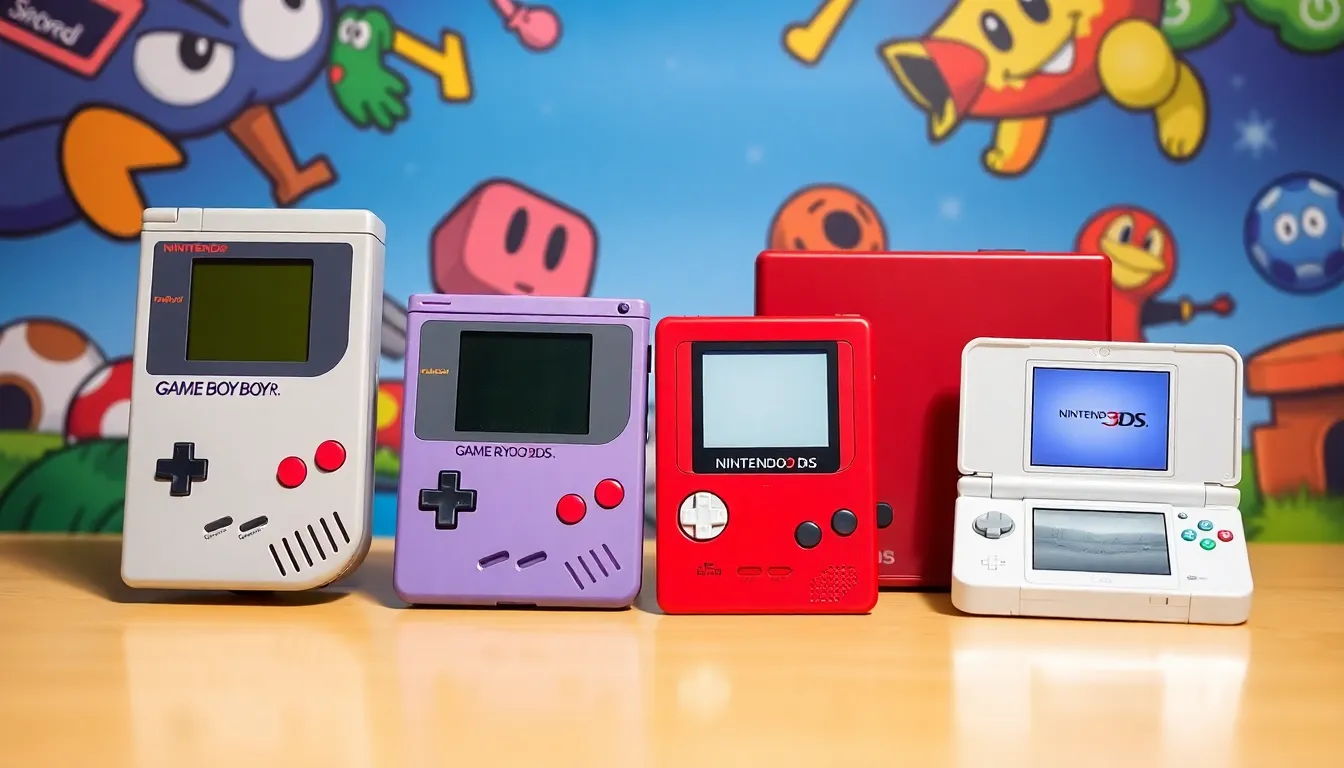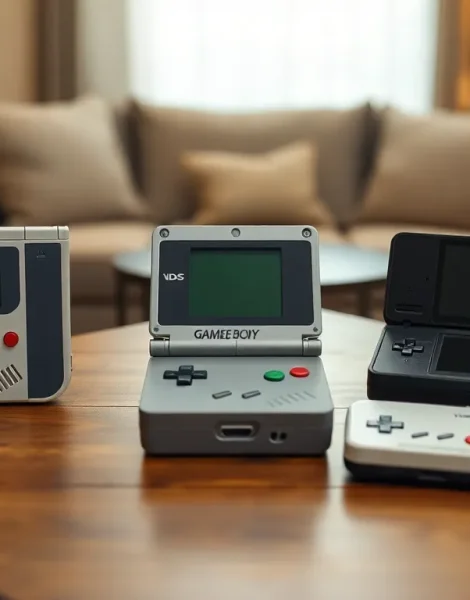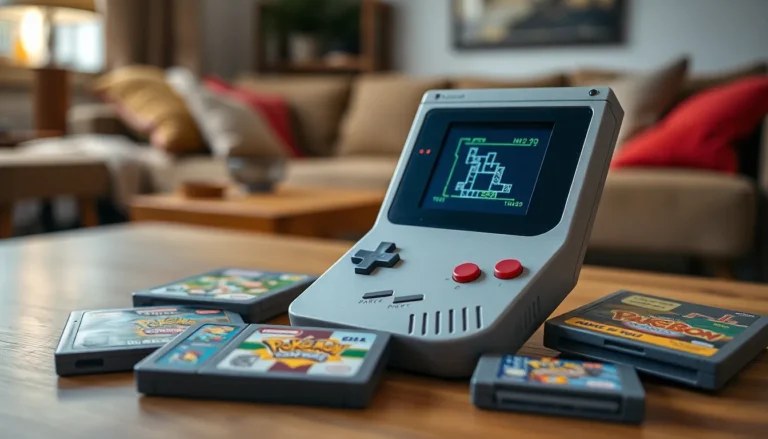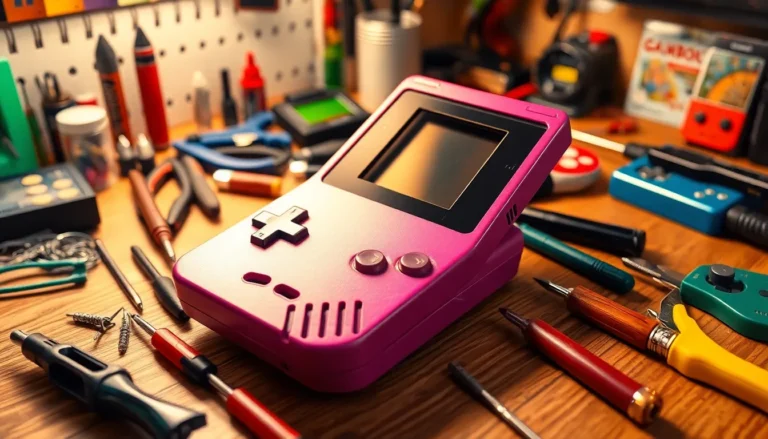From the moment the Game Boy graced the pockets of gamers everywhere, Nintendo’s handheld legacy has been nothing short of legendary. It’s a tale filled with pixelated adventures, unforgettable characters, and the occasional battery-saving trick that turned kids into master strategists. Who knew that a simple device could spark such joy and countless hours of gameplay on long car rides and rainy afternoons?
Table of Contents
ToggleOverview Of Nintendo Handheld Legacy
Nintendo’s influence on handheld gaming reshaped entertainment. Iconic devices have left a lasting legacy in the gaming community.
The Birth Of Handheld Gaming
Nintendo’s journey in handheld gaming began with the Game Boy in 1989. This innovative device combined portability with engaging gameplay. Players loved its simple, intuitive controls, allowing for easy access to a growing library of games. Iconic titles such as Tetris and Super Mario Land captured attention. Gamers embraced the opportunity to enjoy gaming on the go. The success of the Game Boy planted the seeds for future handheld systems.
Key Milestones In Nintendo’s Handheld History
Several significant milestones mark Nintendo’s handheld history. The release of the Game Boy Advance in 2001 expanded capabilities with enhanced graphics and wider game options. Following this, the Nintendo DS launched in 2004, introducing dual screens and touchscreen technology. This innovation increased interactivity and creativity in gameplay. The Nintendo 3DS, released in 2011, brought stereoscopic 3D technology, allowing players to experience depth without glasses. Each advancement contributed to Nintendo’s reputation as a pioneer in handheld gaming, setting benchmarks for future generations.
Iconic Nintendo Handheld Consoles

Nintendo’s handheld consoles play a vital role in shaping portable gaming experiences. Each device introduced innovative features that captivated audiences worldwide.
Game Boy Series
The Game Boy series revolutionized the gaming landscape since its launch in 1989. This series includes the original Game Boy, Game Boy Color, and Game Boy Advance. Players enjoyed a diverse library of titles like Tetris and Pokémon, which appealed to various demographics. Each iteration enhanced graphics and reduced size, promoting portability while maintaining strong gameplay mechanics. The Game Boy Advance introduced 32-bit graphics and a larger screen, providing a more immersive experience. Gamers embraced the series for its strategic gameplay, making it a valuable companion during travel or leisure time.
Nintendo DS Family
Released in 2004, the Nintendo DS family included notable models such as the Nintendo DS Lite and the DSi. Dual screens transformed the gaming experience, allowing for innovative gameplay mechanics. Titles like Nintendogs and Brain Age showcased the system’s unique capabilities. Touchscreen functionality encouraged new interactions within games, engaging players in creative ways. The DSi also introduced cameras, expanding possibilities for user-generated content. With backward compatibility, players accessed an extensive library of Game Boy Advance titles, further enhancing its appeal.
Nintendo 3DS Lineup
The Nintendo 3DS lineup launched in 2011 and featured impressive 3D gameplay without glasses. This series includes the standard 3DS, 3DS XL, 2DS, and the New 3DS models. The introduction of StreetPass and SpotPass changed social gaming, allowing users to connect even while on the go. Popular titles like Mario Kart 7 and The Legend of Zelda: Ocarina of Time 3D captured the hearts of gamers. Enhanced processing power in the New 3DS improved graphics and loading times, providing an upgraded experience. Gamers praised the combination of nostalgia and innovation present in the 3DS lineup.
Impact On Gaming Culture
Nintendo’s handheld consoles significantly shaped gaming culture. These devices influenced the way people interacted with games and each other, reinforcing community and creativity.
Influence On Game Development
Nintendo’s Game Boy pioneered portable gaming, leading developers to create unique gameplay experiences. Iconic titles like Tetris and Pokémon emerged directly from this innovation, establishing standards for future mobile games. The Nintendo DS’s dual screens encouraged developers to experiment with dual-layered narratives and mechanics. Titles like Brain Age demonstrated the potential for educational gaming, pushing developers to explore new genres. Nintendo’s commitment to innovation impacted development cycles, guiding studios to consider portability, control schemes, and user engagement, shaping what handheld gaming can achieve.
Community And Fan Engagement
Nintendo’s handhelds fostered vibrant communities. Features like local multiplayer in games such as Mario Kart DS brought players together, encouraging face-to-face interactions. StreetPass and SpotPass on the Nintendo 3DS enhanced social gaming, allowing players to exchange data and in-game items effortlessly. Fan engagement thrived, with players sharing experiences, tips, and fan art online. Events like Pokémon championships united enthusiasts, expanding the franchise’s reach and sustaining enthusiasm. Collectively, these elements strengthened connections among players, solidifying Nintendo’s legacy within gaming culture.
Future Of Nintendo Handhelds
Nintendo’s handheld legacy continues evolving amidst a dynamic gaming landscape. Significant advancements in mobile gaming provide new opportunities for Nintendo to innovate.
The Rise Of Mobile Gaming
Mobile gaming has surged in popularity, exhibiting impressive growth rates in recent years. Statista reported that mobile gaming revenues are expected to exceed $100 billion globally by 2025. This trend attracts a broad audience, including casual and dedicated gamers. Engaging gameplay and diverse genres enhance mobile gaming’s appeal, leveraging portable platforms for immersive experiences. Meanwhile, smartphone technology improves rapidly, offering features like high-definition graphics and advanced processing power to enrich gameplay.
Speculations On New Devices
Rumors about Nintendo’s upcoming devices continue to circulate. These speculations include potential advancements in augmented reality and cloud gaming features. Analysts suggest a hybrid console that combines elements of both handheld and traditional gaming could appear soon. Interest in such devices reflects players’ desire for innovative experiences. Anticipation grows as Nintendo balances nostalgia with modern technology, ensuring that future handhelds maintain the brand’s legacy while providing new functionalities. Excitement builds around possible collaborations and game releases that complement new hardware.
Nintendo’s handheld legacy is a testament to its innovative spirit and commitment to player engagement. From the iconic Game Boy to the groundbreaking Nintendo Switch, each device has left an indelible mark on gaming culture. These consoles not only transformed how players interact with games but also fostered communities and creativity.
As the gaming landscape continues to evolve, Nintendo’s ability to blend nostalgia with cutting-edge technology keeps players excited for what’s next. The anticipation surrounding future handhelds hints at a promising direction that honors the past while embracing new possibilities. With each iteration, Nintendo reaffirms its position as a leader in the handheld gaming arena, ensuring that its legacy will endure for generations to come.









